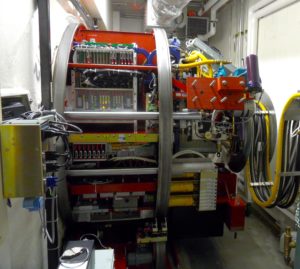How far has cancer technology come?
The machine in the picture delivers radiation therapy, radio therapy, prescribed by radiation oncologists.
It looks like it belongs on the wing of a jet.
Standing about six feet tall, five feet deep, it hooks into the patient related gear in the treatment room.
I used to show up early for cancer tourism.
The behemoth kicks into gear and shoots a beam of radiation.
At me.
Who invents this stuff?
Peter Fessenden, PhD, professor (teaching) of radiation oncology emeritus, arrived at Stanford as the head of the radiation physics section in 1972, just as the original accelerator was retired to the Smithsonian Institution after 16 years of patient treatment.
PF was the new guy ready for the new challenge.
But he didn’t show up unprepared.
He wasn’t coming in to trash all the other work.
He came to build on the results of solid science in cancer technolgy.
Fessenden continued studies he had begun years earlier with the section’s previous leader, exploring how to create linear accelerators that delivered their punch to tumor cells through two types of radiation.
Is this the father of modern radio therapy? Father Fessenden has a nice ring to it.
There must be a connection between the cancer technology of radiation therapy and the origins of radar before WWII and the cavity magnetron?
Any ideas out there from Building 20 on the MIT campus?

via stanford.edu
Working with Varian Medical Systems Inc. of Palo Alto, his group helped develop the first machine that combined both X-ray and electron treatment.
Two types of radiation right here, X-ray and electron treatment.
This is the reason the techs work behind shielded doors and walls.
I’m in on the table thinking, “This must be dangerous.”
“We learned a heck of a lot from this machine, the dos and don’ts,” said Fessenden, who retired in 1995. “Using a lot of that information, Varian went on to develop the precursor to all the modern machines you see now.” Current machines have two or three energies of X-rays and up to seven energies of electrons, giving physicians versatility for crafting the most effective attack.
It did the job on a tumor related to HPV16 throat cancer on my neck.
One little lump needs decades of research and development in cancer technology to hit it like it’s never been hit?
Um, yes it does.
“One of the biggest challenges we have is aligning the radiation beam and the tumor,” said Paul Keall, PhD, the current head of radiation physics. The heart beating, the lungs inflating and deflating with each breath, the blood flowing through the veins, subtle movements of the skeleton or muscles—all this motion adds up to a moving target for a beam of deadly radiation.
This is the part that freaks a P16 throat cancer guy out, what does it for me: DEADLY RADIATION.
What happens if cancer technology misses a neck tumor by just that much?
What else will it hit. There’s a lot of stuff going on in the neck.
Not like other cancer where you could be a little off? Couldn’t you? Hell, no.
They didn’t need to strap me down with a mask. I wasn’t moving. I tried not to breath, or make any subtle movements of my skeleton or muscles.
Slowed down blood flow and my lowered my heart rate by chanting a special phrase.
A linear accelerator was co-developed at Stanford that can continually track the position of tumors in real time during treatment. Tracking allows clinicians to deliver larger doses of radiation precisely to the tumor.
This is where video games and kids playing endless hours pays off.
If my clinician played enough bomber games, or duck hunting games, and won, he ought to show a diploma.
When you look at modern medical linear accelerators, said Hoppe, “they are light-years ahead of that unit built by the physicists at Stanford in the early 1950s.” But what is in store for a cancer patient 50 years from now?
Where do the old medical linear accelerators go? I’ve heard they’re used for treatment in third world countries where patients still get a large dose of radiation.
The next generation of radiotherapy will encompass the techniques of molecular imaging, which allows doctors to differentiate tumor from normal tissue.
Rest easy in the future. No more sore throats for Portland P16 throat cancer?
Hard to imagine with all the delicate neck tissue.

via stanford.edu
“We are developing tools that allow us to deliver more radiation into the parts of the tumor that are most resistant to radiation,” said Keall. “So there is quite a good fusion here of the molecular imaging and biology and the physics, which can be translated to better cancer treatment through the use of the linear accelerator.”
And the crowd cheers.
I cheer. I cheered. I’m still cheering. I cheer for the Knight Cancer Institute and Providence radiation oncology.
One day after radiation treatment I asked Dean if he’d ever heard the noise his machine made.
“It comes in three tones.”
“We have a tiny speaker. We hear it, but not too well.”
“I hope you never have to hear it any better.”
It was a manly moment of common human decency, and I got to be the decent one.
In spite all of the high and low tech cancer technology, I wouldn’t wish this on any one.




[…] instance, if you had radiation treatment for cancer thirty years ago, which is half a lifetime if you’re sixty and bad at math, you got […]